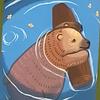You need to sign in or sign up before continuing.
Take a photo of a barcode or cover
adventurous
dark
funny
mysterious
medium-paced
Plot or Character Driven:
Character
Strong character development:
Yes
Loveable characters:
Complicated
Diverse cast of characters:
Yes
Flaws of characters a main focus:
Yes
DNF- What I DID read was a 1. I didn't know it was even possible for absolutely nothing to happen in the course of 130 pages. Peake surely did accomplish a feat with that!
took me a long time to get into this b/c of how glacially paced it is but when i finally did it was p life changing. it’s like watching someone paint vast ornate miniatures, or like watching wax figures melt very very slowly; at first you’re antsy, then something clicks, and it’s mesmerizing.
dark
reflective
tense
slow-paced
Plot or Character Driven:
Character
Strong character development:
Complicated
Loveable characters:
Complicated
Diverse cast of characters:
No
Flaws of characters a main focus:
Yes
challenging
dark
funny
mysterious
slow-paced
Plot or Character Driven:
A mix
Strong character development:
Complicated
Loveable characters:
Complicated
Diverse cast of characters:
Yes
Flaws of characters a main focus:
Yes
Esse livro foi um tanto diferente do esperado. Embora seja considerado fantasia, a verdade é que se aproxima muito mais de um realismo mágico, com alguns toques góticos. Tem uma série de elementos de worldbuilding, mas, ao mesmo tempo, traz referências ao que podemos considerar como o mundo real. Também é muito diferente da fantasia tradicional em seu tom. Nada aqui é realmente épico, mas sim tem uma dose muito forte de caricatura. Ao mesmo tempo que não se adequa à seriedade da fantasia tradicional, também não posso dizer que é um livro engraçado, ao menos não na do modo que o é a fantasia de Terry Pratchett. Não temos aqui nenhum personagem que possamos chamar de herói, mesmo o que poderíamos chamar de protagonista me parece ser, na verdade, o vilão da série de livros como um todo. O que faz com que esse seja uma espécie de prólogo. Os dois elementos que sobressaem em Titus Groan são a linguagem de Mervyn Peake, extremamente rebuscada, com muitos jogos de palavra, muitos rococós e altamente estilizada, ao lado do castelo de Ghormengast como um todo. Talvez por ser o castelo o verdadeiro herói, não possamos dar esse título a nenhum dos outros personagens. O que fica um pouco cansativo. É um livro longo para ficarmos lendo de novo e de novo sobre como X é burro ou como Y é incapaz de falar ou Z é creepy. Isso para não entrar nas descrições físicas, das quais poucos personagens escapam, sejam por sua extrema magreza, seus narizes enormes ou o que seja. A leitura fica um pouco difícil, com essa junção de fatores, mas tem seus elementos recompensadores também. Pretendo ler os próximos volumes, mas uma pausa será necessária.
Borrring! I dnf’d at chapter 21. There is no plot in this just depressing characters living in a depressing castle.
Proust but if pushed to a fantastical, more accessible boundary and less focused on the psychological regards of its characters. I'm obsessed with so many sentences in this, as they are basically cubist paintings morphed through linguistic transposition. But I also do not care about anything in this plot less novel THAT much. So what can you do. Steerpike is a beast, but I'm also very much interested in his brutal social climbing, and the general humor in the novel is quality. I'm hoping the next book does more with its plot when Titus isn't an infant. Maybe this will feel more like a prologue rather than the major novel of the series. I hope.
challenging
dark
mysterious
sad
slow-paced
Plot or Character Driven:
Character
Strong character development:
Complicated
Loveable characters:
Complicated
Diverse cast of characters:
Yes
Flaws of characters a main focus:
Yes
Wow. What a strange and compelling read. I’ve yet to encounter any other author with Peake’s ability to convey every painstaking, morbid detail of each scene in such complete and fascinating verbosity.
To me, the Gormenghast Trilogy is much more akin to visual art than any type of literary narrative we might typically expect. Peake’s virtuosity as an illustrator is heavily employed in this regard throughout the story. Like a Renaissance painting, it is rich in exquisite detail; a live tapestry of contemporaneous happenings. What thinly strung plot there is in this story is used less as a means of driving narrative and more as visual cue, goading the eye from one ornate periphery of the artwork to the next. From the lonely Steerpike ravenously biting into a wrinkled pear in a dusty forgotten attic, to the whirling greasy cyclone of Swelter’s blade reflecting the sparse moonlight in the Hall of Spiders.
This is where the novel shines. In painting ludicrous scenes within the readers’ minds; scenes of crumbling destitute castles, crippling yet comical neuroses, morbid decrepitude of body, and multiple paragraphs describing the numerous folds of a man’s chin. Many of these snapshot scenes I will be happy to revisit in the years to come.
To me, the Gormenghast Trilogy is much more akin to visual art than any type of literary narrative we might typically expect. Peake’s virtuosity as an illustrator is heavily employed in this regard throughout the story. Like a Renaissance painting, it is rich in exquisite detail; a live tapestry of contemporaneous happenings. What thinly strung plot there is in this story is used less as a means of driving narrative and more as visual cue, goading the eye from one ornate periphery of the artwork to the next. From the lonely Steerpike ravenously biting into a wrinkled pear in a dusty forgotten attic, to the whirling greasy cyclone of Swelter’s blade reflecting the sparse moonlight in the Hall of Spiders.
This is where the novel shines. In painting ludicrous scenes within the readers’ minds; scenes of crumbling destitute castles, crippling yet comical neuroses, morbid decrepitude of body, and multiple paragraphs describing the numerous folds of a man’s chin. Many of these snapshot scenes I will be happy to revisit in the years to come.







